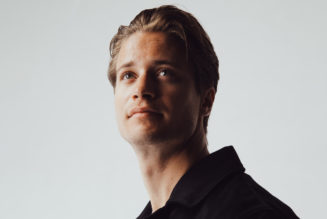In the beginning, it seemed like Nina was just an imaginary friend.
Two-year-old Aija had invented plenty of fictional characters before, but her parents — Ross, a musician, and Marie, a psychologist — noticed right away that Nina was different. (The family spoke to The Washington Post on the condition that only their middle names be used because of the sensitivity of the subject and because Aija is a young child.) From the time Aija learned how to talk, she talked about Nina, and her descriptions were remarkably consistent. Aija told her parents that Nina played piano, and she loved dancing, and she favored the color pink (Aija emphatically did not). When Aija spoke as Nina, in the first person, Aija’s demeanor changed: Her voice was sweeter and higher-pitched, her affect more gentle and polite than what Marie and Ross typically expected from their rambunctious toddler.
Aija sometimes told them that Nina was afraid of bad guys coming to get her, or of not having enough food to eat; Aija once hid a bowl of cereal and told her mother it was for Nina. One day, when Marie was using the food processor in the kitchen, Aija reacted with horror to the sound: “Get the tank out of here!” she shrieked. Marie couldn’t fathom how her daughter knew the word “tank.”
It all seemed more curious than concerning — until one afternoon in the early spring of 2021, when Marie came to believe that there was something more to Nina. That day, Marie recalls, she and Aija were playing together in their living room, enacting little scenes with toy figurines.
Then Aija suddenly turned to her mother and said, “Nina has numbers on her arm, and they make her sad.”
Marie’s mind raced. “What did you say?” she asked her daughter, willing her voice to remain calm.
“Nina has numbers on her arm, and they make her sad,” Aija said again, pointing to the inside of her forearm. Then she added: “Nina misses her family. Nina was taken away from her family.”
It wasn’t just the words that sent a jolt of adrenaline through Marie’s body, or the way her child said them — clear and certain, with the letter R pronounced correctly, which Aija usually couldn’t manage — but there was also something about Aija’s expression in that moment.
Nearly three years later, Marie tries to explain it: “There was just —” she pauses. “There was such deep pain there.” It seemed beyond what a toddler should know: “The look on her face, it was too old,” Marie says. “Does that make sense?”
It does, and it doesn’t, even to her, even now. What she knows: that her toddler had never heard anything about the Holocaust, and could not possibly recognize the significance of numbers on a forearm. Marie knows how this story might sound, and she is exceedingly careful about sharing it.

“There was just —
there was such deep
pain there. The look
on her face, it was too old.
Does that make sense?”
Marie, Aija’s mom

“There was just — there was
such deep pain there.
The look on her face, it was too old.
Does that make sense?”
Marie, Aija’s mom

“There was just — there was such deep pain there.
The look on her face, it was too old. Does that make sense?”
Marie, Aija’s mom

“There was just — there was such deep pain there.
The look on her face, it was too old. Does that make sense?”
Marie, Aija’s mom
Marie also knows that she is not alone — that since the 1960s, more than 2,200 children from across the world have described apparent recollections from a previous life, all documented in a database maintained by the Division of Perceptual Studies within the Department of Psychiatry and Neurobehavioral Sciences at the University of Virginia School of Medicine. Sometimes a child presents enough identifying information for relatives or researchers to pinpoint a deceased person, but that level of specificity is elusive; about a third of the cases in the database do not include such a match.
The phenomenon, with its aura of the paranormal, has long been fodder for books, academic studies, newspaper stories and dramatized documentaries. All of these explorations tend to orbit the same existential questions: Is reincarnation real? What happens after we die? How can this be explained? But there is, of course, no scientific means to conclusively prove — or disprove — a mechanism that might explain how a person could recall living a past life.
Which leaves parents such as Marie and Ross to navigate an inexplicable, often isolating experience. Something is happening, that much they know, and so they find themselves facing different but equally daunting questions: What happens — what does it mean, what do you do — when, one day, your child tells you they remember being someone else?
Some of the most notable cases began with a child crying in the night.
In Louisiana in 2000, 2-year-old James Leininger would wake screaming, repeating the same phrases to his baffled and disturbed parents: “Airplane crash on fire! Little man can’t get out!” Over the following year, a story unspooled in memories and drawings: He was a World War II pilot whose plane took off from a boat, and he died when he was shot down by Japanese forces. James offered names of people and places, and his account would ultimately become one of the most prominent and thoroughly documented “cases of the reincarnation type,” or CORT, ever recorded.
In Oklahoma in 2009, 5-year-old Ryan Hammons would lie awake at night and plead: “Can I go home? Can I see my mom?” or “What happened to my children?” Sometimes, he would climb tearfully into his mother’s bed. He was lying beside her one night, Cyndi Hammons remembers, when he said that he needed to tell her something. “I think I used to be somebody else,” he whispered.
Soon after Aija told her mother about the numbers on Nina’s forearm, Aija also began to wake at night in a state of agitation. Crying and pacing in her room, she would say she was afraid of eyes staring at her in the dark, or “bad guys” who would take her away, or bluish clouds that were “coming to kill us all.”
By that point, Marie says, she had done more reading about children who seem to recall past lives, and felt convinced that Aija was experiencing the same phenomenon. “I always tried to remain open-minded,” Marie says. Ross was less certain, but he agreed that whatever was happening seemed extraordinary.
In the moments when Aija seemed scared or inconsolable, her parents learned that what helped most was simply to stay close. They would hold her, or sit calmly on the floor, and remind her that she was safe. “I didn’t know what to do except love her through it,” Marie says. Aija, who was otherwise a fearless and happy kid, sometimes seemed to share their bewilderment. One night, as Marie tried to soothe her daughter, Aija asked a question her mother couldn’t answer: “Why do I have these bad pictures in my heart?”
Marie eventually shared these stories with a few trusted friends from her graduate school psychology program. “They were like, ‘This is not normal for a 2-year-old,’” she says.
For many of the parents who find themselves in this surreal circumstance, there comes a point when they realize that it is not a passing phase. It isn’t the kind of topic they can research in parenting books or casually bring up to their peers at the playground.
So they do what any parent might do when they have a question they’re not sure how to answer: They turn to the internet. They pull up Google — child talking about past life? — and discover a search result that looks startlingly legitimate. “Advice to Parents of Children who are Spontaneously Recalling Past Life Memories,” reads the headline on the page of the University of Virginia School of Medicine’s website, and further down, “Contact Us,” and that is how they come to the attention of Jim Tucker.
As director of the Division of Perceptual Studies (DOPS) at the University of Virginia for the past 10 years, Tucker has worked directly with nearly 150 families, making comprehensive records of children’s descriptions of past-life memories.
Tucker inherited this work from Ian Stevenson, U-Va.’s former psychiatry department chairman and the founder of the division that would eventually become DOPS. Beginning in the 1960s, Stevenson traveled the world documenting cases of the reincarnation type, publishing academic papers and a number of books about his findings before his death in 2007. Stevenson’s reputation — even among those skeptical of the topic — was that of a serious and scrupulous scientist, someone who openly examined both the strengths and weaknesses of the cases he chronicled.
Tucker learned of Stevenson’s research while completing his residency at U-Va., but he didn’t become more interested until nearly a decade later. After nine years in private practice as a child psychiatrist, Tucker married a clinical psychologist who was curious about reincarnation, telepathy and near-death experiences. “That opened me up a little,” Tucker says, and in 1996 he began assisting Stevenson with a study of people who had had near-death experiences. Since joining the School of Medicine full time in 2000, Tucker has split his focus between DOPS and his work as a clinician and professor of psychiatry and neurobehavioral sciences.
Stevenson’s ideas faced no shortage of criticism from the scientific community: Some maintain that consciousness is generated by the brain and therefore cannot survive beyond its death; others have speculated that the children he documented could be reciting “false memories,” having been unintentionally pushed toward a particular narrative by their parents.
Tucker shares Stevenson’s desires for these critics to engage with the evidence in the case reports, and for the work of DOPS to be destigmatized; but Tucker’s own goal is more personal. “In many ways, I am doing this to try to sort it out for myself,” he says. “With each case, I come in with certainly an openness, but also, I think, a fairly critical eye: What is the level of evidence, and could it be explained in other ways?”
Certain consistent patterns have emerged: The most pronounced and convincing cases, Stevenson and Tucker both found, tend to occur in children between the ages of 2 and 6. They might suddenly describe places they have never been, people they have never met, sometimes using words or phrases that seem beyond their vocabulary. Nightmares or sleep disturbances are occasionally reported. Many of these children are highly verbal and start speaking earlier than their peers. Their descriptions of past-life recollections often fade away entirely by the time the child turns 7 or 8.

“In many ways, I am
doing this to try to sort it out
for myself. With each case,
I come in with certainly
an openness, but also,
I think, a fairly critical eye:
What is the level of evidence,
and could it be explained
in other ways?”
Jim Tucker, director of the
Division of Perceptual Studies
at the University of Virginia

“In many ways, I am doing this
to try to sort it out for myself.
With each case, I come in with
certainly an openness, but also,
I think, a fairly critical eye:
What is the level of evidence,
and could it be explained
in other ways?”
Jim Tucker, director of the Division of Perceptual
Studies at the University of Virginia

“In many ways, I am doing this to try to sort it out for myself.
With each case, I come in with certainly an openness, but also,
I think, a fairly critical eye: What is the level of evidence,
and could it be explained in other ways?”
Jim Tucker, director of the Division of Perceptual Studies at the University of Virginia

“In many ways, I am doing this to try to sort it out for myself.
With each case, I come in with certainly an openness, but also,
I think, a fairly critical eye: What is the level of evidence,
and could it be explained in other ways?”
Jim Tucker, director of the Division of Perceptual Studies at the University of Virginia
These similarities span accounts recorded around the world. Among the cases in the DOPS database, about 15 percent are North American; of those, an overwhelming majority are from Indigenous communities. “There’s no question that the cases are easier to find in cultures where there’s a belief in reincarnation,” Tucker says.
The true prevalence of this phenomenon is difficult to know, Tucker says — particularly given that many families might not recognize it, or might actively suppress it — but DOPS is contacted by about 120 families per year, most of whom are American. If a child’s recollections are detailed enough to potentially identify a particular individual, DOPS opens an investigation, and the case is entered into the database.
But even if a child can offer that level of specificity, sometimes parents don’t want to know more. “That can be the frustrating part, where you get what starts like a really interesting case, but then the parents don’t stick with you,” Tucker says.
Other times, parents can be too intrigued — which can muddle potential evidence. If parents ask leading questions, or if children learn that certain statements are met with dramatic or enthusiastic responses, it can be difficult to discern whether a child is just trying to please their parents.
Tucker is convinced that the vast majority of families he’s met are not lying or embellishing their accounts to draw attention. In fact, he says, the opposite is often true: Many parents are quite unsettled by their child’s claims and do not want to publicly share them.
That impression is echoed by Tom Shroder, a former Washington Post editor and author of “Old Souls: Compelling Evidence From Children Who Remember Past Lives,” who accompanied Stevenson as he studied cases in Lebanon and India. None of the families they interviewed, Shroder says, seemed to have any personal or material motive to misrepresent what they’d witnessed. “They were normal people relating their experiences,” he says. And what they were describing of their children, he says, “is so clearly not normal imaginative behavior.”
Tovah Klein, a leading child development psychologist and author who directs the Barnard College Center for Toddler Development in New York, confirms that assertion.
She explained that at age 2 or 3, children engage in fantasy play, but they are not likely to fabricate a statement involving their primary relationships. In other words: Saying “You’re not my mom” or “I want my other parents” or “Where are my children?” — common among these cases — is not something you would typically expect a very young child to say, let alone repeat insistently. “It doesn’t sound like confusion,” Klein says. “It sounds like a real statement. And young children just don’t make this kind of thing up.”
What to make of that, then? Being receptive to this kind of message from a child requires a degree of openness that might feel challenging, Klein says, particularly in the absence of a clear scientific explanation.
“Sitting with the unknown, for humans, is perhaps the hardest thing we have to do,” she says. “But we owe it to a child, we owe it to the family, to listen, and to try to understand and support them, wherever they are, whatever is happening.”
On a sunny Saturday morning in late August, Tucker parks his car on a suburban neighborhood street in Alexandria, Va., outside the home of one of Marie’s friends. “Let’s see what we have here,” he says as we walk to the front door of the house, where we are greeted by Marie, her friend Shawn, and Aija, a petite, elfin child in a Spider-Man T-shirt, her wispy blond hair tied in a loose topknot.
We settle inside, where Aija plays with magnetized blocks and munches graham crackers, while Marie and Tucker go over paperwork for the research study. Tucker is poised and soft-spoken, his tone calm and steady when he leans forward to speak to Aija. “I understand you’ve been talking about Nina,” he says.
“Yeah!” Aija chirps in a sweet, singsong voice.
“What can you tell me about Nina?” Tucker asks.
“Oh!” Aija says. “She is being me.”
Tucker mishears this: “She’s being mean?” he asks.
Aija shakes her head. “She’s being me.”
Tucker nods. “Well, one thing your mom mentioned was that Nina had some numbers on her arm. Can you tell me about that?” At this question, Aija lowers her eyes and falls silent, pressing her small body against the couch cushions. “Don’t want to talk?” Tucker says gently. He is well accustomed to the challenges of conversing with a small child and never pushes beyond what feels comfortable. “Well, I will talk with your mom a little bit about Nina, and then you speak up any time you want to, all right?” he says, and Aija nods.
“Do you remember the first things she would say about Nina?” Tucker asks Marie.
“She would say that Nina is very fancy,” Marie says. “And she also sometimes would be very theatrical. That or shy. Her personality has been really consistent since we started hearing about Nina.”
“Were there things that made you think this was different from an imaginary friend?” Tucker asks.
“Just the consistency,” Marie says. “And like, who Nina was and her background.”
Over the next hour, Marie describes standout moments from Aija’s story: How she once sat down at a piano and sounded out the melody to “Twinkle, Twinkle, Little Star” and when her parents reacted with surprise, she said, “Nina taught me how to do that.” How Aija sometimes cried when she spoke of how Nina missed her family. How Aija once dramatically declared to her parents, “Ladies and gentlemen, welcome to the end of the world!” and curtsied.
“It’s a little disturbing to hear that from a 2-year-old, especially in the middle of a pandemic,” Marie says with a slight laugh.
Tucker nods. “You kind of wonder where she even picked up the expression.”
Throughout their conversation, Tucker is thorough and attentive, carefully recording each detail Marie shares. At moments when Marie or Shawn become animated about something Aija has said — at one point, they wonder whether Aija’s reaction to the cover of a book written by a Holocaust survivor might be a sign of some connection to the author — Tucker remains impassive and pragmatic.
“It’s not always clear how we should put the pieces together,” he tells them. He understands the impulse to identify a specific person Aija might be recalling, but “most of the time, certainly in the American cases, we’re not able to identify one particular person,” he says. “Presumably there were a lot of Ninas in concentration camps.”
Toward the end of the interview, their discussion turns toward what the experience has felt like for Aija and her family. Marie talks about how they’ve neither prompted nor discouraged Aija from talking about Nina, responding instead with a neutral openness. Tucker nods approvingly.
“The good news is that this stuff almost always fades, and will often disappear, and hopefully over the next year or two you’ll be hearing less and less about Nina,” Tucker says. The more Aija becomes fully involved in this life, he says, the more Nina will recede: “Often school helps them do that.”
Later, when I call Tucker to ask him what he thought of Aija’s story, he says that he found the family’s account compelling, but there was not enough specific detail to continue an investigation. “It basically becomes one more unverified American case,” he says.
But even if Tucker couldn’t guide Aija’s family toward a clear resolution, it seems he provided something perhaps even more meaningful. “I felt so much validation,” Marie tells me. “I have been having this feeling, like, ‘This is so profound; is anyone else seeing this?’ And I felt like we were finally seen.”
It made her think that, at some point, she might seek out another parent who has gone through this before, someone who could tell her how it all plays out. “I would love that support,” she says. “Just to talk to these parents, like — what have they done? How do they feel?”
Over the past dozen years, Cyndi Hammons has grown adept at fielding the messages that appear in her Facebook inbox, sent by overwhelmed parents who don’t know what to do about children who seem to be remembering a past life.
“Anybody who is struggling with it, I tell them, ‘You’re going to make it through,’” she says. Mostly, she just tries to listen and offer understanding. “I don’t know that I’ve helped anybody, but I know what it feels like. I know what the fear feels like, what the judgment feels like, and it’s heavy,” she says. “And most cases aren’t solved. Ryan’s was solved. So I was very lucky.”
It didn’t feel lucky in the beginning, when Ryan was waking up sobbing at night and describing things his mother couldn’t fathom: that he remembered living in Hollywood in a big white house with a swimming pool. That he once had three sons and a younger sister. That he drove a green car, and his wife drove a black one.
“It felt like living with someone who had Alzheimer’s, mixed with grieving,” Cyndi says. But that someone was her small child, and all she wanted was for him to feel safe and happy.
Cyndi didn’t tell anyone at first, not even her husband, Ryan’s father. Kevin Hammons was the son of a Church of Christ minister, a police officer in their small town in Oklahoma, and Cyndi knew what he would think. For months, it remained a secret between mother and son. She brought home library books about Hollywood in the 1940s so Ryan could leaf through the pages. When he wanted to collect sunglasses instead of Hot Wheels, or window-shop for suit jackets, or listen to Bing Crosby, “that’s what we did,” Cyndi says.

“It felt like living
with someone who
had Alzheimer’s,
mixed with grieving.”
Cyndi Hammons, Ryan’s mom

“It felt like living with
someone who had Alzheimer’s,
mixed with grieving.”
Cyndi Hammons, Ryan’s mom

“It felt like living with someone
who had Alzheimer’s, mixed with grieving.”
Cyndi Hammons, Ryan’s mom

“It felt like living with someone
who had Alzheimer’s, mixed with grieving.”
Cyndi Hammons, Ryan’s mom
But Ryan’s night terrors and recollections did not stop, and eventually Cyndi told Kevin what was happening. He didn’t initially accept the possibility of reincarnation, she says, but as a detective, he told her to write down everything Ryan said. Not long after, Ryan saw a man he recognized in one of his library books, a peripheral figure in a photograph of six men: “That’s me!” he told his mother.
Cyndi wrote to Tucker, and in April 2010, with the help of a production crew from the A&E series “The Unexplained,” they were able to identify the man as Marty Martyn, a movie extra and talent agent who died in 1964.
With Tucker and the television crew, Cyndi and Ryan traveled to California to meet Martyn’s daughter, Marisa Martyn Rosenblatt, who was 8 when her father died. She was skeptical — but she ultimately confirmed many of Ryan’s statements about Marty Martyn, including some she hadn’t realized were correct. She didn’t know that her father had driven a green car, or that he had a younger sister, but it turned out both claims were accurate. Marty Martyn’s death certificate cited his age as 59, but Ryan insisted he had died at 61; Tucker found census records and marriage listings that confirmed this, as did Martyn’s daughter.
When the episode of “The Unexplained” aired in 2011, it catapulted the Hammons family into a different realm, where their names were in newspaper headlines, and everyone in their town knew Ryan’s story.
“Kevin and I had professional jobs. I was a county clerk’s deputy for 14 years,” Cyndi says. “We were known in our community.” But that didn’t stop people from telling her their thoughts: Your child needs to find Jesus. You’re a bad parent. Are you doing this for money?
“People don’t really understand this unless they’ve lived it,” she says. “Everything pivoted around protecting Ryan. I didn’t care what anyone thought about me — it didn’t matter. I knew the truth, and I just knew that Ryan had to be okay.”
Ryan is a college junior now. He doesn’t remember being Marty Martyn anymore, and this isn’t a story he shares when he meets people. He still isn’t sure how to label what he experienced: “I’m open to anything,” he says, “but I cannot say with certainty that reincarnation is real.” He says he is at peace with the unknown, focused now on his future.
But he knows his mother is still searching for answers about what they lived through. Time has made Cyndi the lone keeper of those memories: Ryan’s father died two years ago, and Ryan’s recollections have faded. “It isn’t really my story,” he says. “It’s kind of her story now.”
A few weeks after Marie and Aija meet with Tucker in Virginia, Aija starts attending preschool — and as Tucker had predicted, Nina’s presence begins to subside. Aija is enthralled with her new school and the friends she makes there.
Several months later, on a cold Sunday morning in February, Aija twirls and dances to a playlist of favorite songs in the bright living room of her grandmother’s house in Michigan. Her parents sit nearby, describing a transition that feels, to them, like the beginning of an ending. Only months ago, they say, Aija would speak as Nina, or about Nina, nearly every day; now, several days might pass without any reference to her. So far, Nina has never been mentioned at school, at least not to their knowledge. Aija turned 5 in December, and Tucker had told Marie that past-life recollections often begin to fade around this age.
As a family, they’ve been reflecting on their experience recently. Marie feels certain that Nina is some sort of distinct entity, that Aija carries memories that aren’t her own. Ross’s mother — whom Ross describes as “more conservative” — is convinced that Nina is just an imaginary friend, like the ones Ross used to conjure when he was a small boy. Ross says he understands the human impulse to name something so mystifying, but he doesn’t share that need. “The mystery — I can observe it, but I don’t need to define it,” he says.
Months have passed since Aija described the frightening imagery that once defined her night terrors, and Marie says she would be profoundly relieved if those episodes never returned. “You never want to see your child suffer,” she says. “I hope she never has dreams of that intensity again.”
Yet Nina has also been a source of joy for Aija — a companion of sorts, whose presence has infused moments of her early childhood with a gentle, delicate charm. That, too, is beginning to recede, which feels more poignant to Marie: “There is a kind of nostalgia, already.”
Ross nods in understanding. But he feels more at peace with the ebbing of Nina’s influence, he says; it seems to mirror so much of parenthood, the constant movement from one uncharted landscape to the next. “The disappearance of it feels like part of the natural progression,” he says. As a family, they have learned to stay open to whatever comes.
Marie lifts her phone to select a new song to play, and Aija raises her arms into position for her next dance. She looks at her parents and grins. “Are you ready?” she asks.









